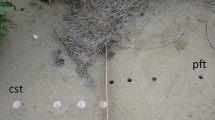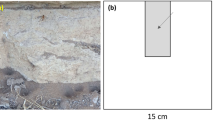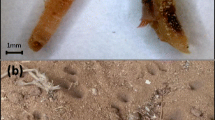Abstract
Larvae of pit-building antlions are expected to be more efficient at capturing prey than those of non-pit-builders. To test this prediction, feeding behaviors were compared in the same experimental conditions among pit-building Baliga micans and Myrmeleon bore, and non-pit-building Distoleon contubernalis. The number of prey eaten did not differ between species. D. contubernalis larvae used the walls of the experimental chamber as fence traps to capture prey. In the field, they were also found near edges of natural barriers, such as rocks, stones, tree roots, and plant stems. Artificial pitfall traps captured more arthropods near the edges of fences than farther from them. Larvae of the two pit-building species were located in the central part of the experimental chamber. In their natural habitats, the number of arthropods captured by artificial pitfall traps increased with pit size; thus, larger pits may be more efficient for capturing prey. In conclusion, pit-building and non-pit-building antlion larvae are both efficient hunters; the former hunt efficiently by making larger pitfall traps, and the latter do so by waiting for prey at the edge of the natural fences along which arthropods walk.







Similar content being viewed by others
References
Ábrahám L (2003) Temperature tolerance and predatory strategy of pit-building ant-lion larvae (Neuroptera: Myrmeleontidae). Acta Phytopathol Entomol Hung 38:167–179
Allen GR, Croft DB (1985) Soil particle size and the pit morphology of the Australian ant-lions Myrmeleon diminutus and M. pictifrons (Neuroptera: Myrmeleontidae). Aust J Zool 33:863–874
Antoł A, Rojek W, Miler K, Czarnoleski M (2018) Thermal dependence of trap building in predatory antlion larvae (Neuroptera: Myrmeleontidae). J Ethol 36:199–203
Baba K (1953) The biology of antlions. Essa Entomological Association, Niigata (in Japanese)
Baba K, Nagatomi A, Nagatomi H, Evenhuis NL (1987) Redescription of Villa myrmelenostena (Insecta, Diptera, Bombyliidae), a parasitoid of ant lion in Japan. Zool Sci 4:903–911
Badano D, Aspöck U, Aspöck H, Cerretti P (2017) Phylogeny of Myrmeleontiformia based on larval morphology (Neuropterida: Neuroptera). Syst Entomol 42:94–117
Barkae ED, Scharf I, Abramsky Z, Ovadia O (2012) Jack of all trades, master of all: a positive association between habitat niche breadth and foraging performance in pit-building antlion larvae. PLoS One 7:e33506
Barkae ED, Scharf I, Ovadia O (2017) Differential effects of variance in prey arrival on foraging success and growth rate of two pit-building antlion species. J Zool 303:254–260
Brown MB, Forsythe AB (1974) The small sample behavior of some statistics which test the equality of several means. Technometrics 16:129–132
Cain ML (1987) Prey capture behavior and diel movement of Brachynemurus (Neuroptera: Myrmeleontidae) antlion larvae in south central Florida. Florida Entomol 70:397–400
Creed RP Jr, Miller JR (1990) Interpreting animal wall-following behavior. Experientia 46:758–761
Crowley PH, Linton MC (1999) Antlion foraging: tracking prey across space and time. Ecology 80:2271–2282
Devetak D (2014) Sand-borne vibrations in prey detection and orientation of antlions. In: Cocroft RB, Gogala M, Hill PSM, Wessel A (eds) Studying vibrational communication. Animal signals and communication, vol 3. Springer, Heidelberg, pp 319–330
Devetak D, Arnett AE (2015) Preference of antlion and wormlion larvae (Neuroptera: Myrmeleontidae; Diptera: Vermileonidae) for substrates according to substrate particle sizes. Eur J Entomol 112:500–509
Devetak D, Mencinger-Vračko B, Devetak M, Marhl M, Špernjak A (2007) Sand as a medium for transmission of vibratory signals of prey in antlions Euroleon nostras (Neuroptera: Myrmeleontidae). Physiol Entomol 32:68–274
Devetak D, Lipovšek S, Pabst M-A (2010) Larval morphology of the antlion Neuroleon microstenus (McLachlan, 1898) (Neuroptera, Myrmeleontidae), with notes on larval biology. Zootaxa 2428:55–63
Devetak D, Novak T, Janžekovič F (2012) Effect of substrate density on behaviour of antlion larvae (Neuroptera: Myrmeleontidae). Acta Oecologica 43:1–7
Devetak D, Klokočovnik V, Lipovšek S, Bock E, Leitinger G (2013) Larval morphology of the antlion Myrmecaelurus trigrammus (Pallas, 1771) (Neuroptera, Myrmeleontidae), with notes on larval biology. Zootaxa 3641:491–500
Elimelech E, Pinshow B (2008) Variation in food availability influences prey-capture method in antlion larvae. Ecol Entomol 33:652–662
Ezawa A, Tsurusaki N (2015) Distribution of coastal species of antlions (Neuroptera: Myrmeleontidae) in Tottori Prefecture. Nat Hist Res San’in 11:45–53 (in Japanese)
Fertin A, Casas J (2006) Efficiency of antlion trap construction. J Exp Biol 209:3510–3515
Fertin A, Casas J (2007) Orientation towards prey in antlions: efficient use of wave propagation in sand. J Exp Biol 210:3337–3343
Furunishi S, Masaki S (1981) Photoperiodic response of the univoltine ant-lion Myrmeleon formicarius (Neuroptera, Myrmeleontidae). Kontyu 49:653–667
Furunishi S, Masaki S (1982) Seasonal life cycle in two species of ant-lion (Neuroptera: Myrmeleontidae). Jpn J Ecol 32:7–13
Furunishi S, Masaki S (1983) Photoperiodic control of development in the ant-lion Hagenomyia micans (Neuroptera, Myrmeleontidae). Entomol Generalis 9:51–62
Gatti GM, Farji-Brener AG (2002) Low density of ant lion larva (Myrmeleon crudelis) in ant–acacia clearings: high predation risk or inadequate substrate? Biotropica 34:458–462
Griffiths D (1980) The feeding biology of ant-lion larvae: prey capture, handling and utilization. J Anim Ecol 49:99–125
Griffiths D (1982) Tests of alternative models of prey consumption by predators, using ant-lion larvae. J Anim Ecol 52:363–373
Griffiths D (1985) Phenology and larval-adult size relations in the ant-lion Macroleon quinquemaculatus. J Anim Ecol 54:573–582
Griffiths D (1986) Pit construction by ant-lion larvae: a cost-benefit analysis. J Anim Ecol 55:39–57
Griffiths D (1991) Intraspecific competition in larvae of the ant-lion Morter sp. and interspecific interactions with Macroleon quinquemaculatus. Ecol Entomol 16:193–201
Hauber ME (1999) Variation in pit size of antlion Myrmeleon carolinus larvae: the importance of pit construction. Physiol Entomol 24:37–40
Hayashi M (2013) Antlions (Neuroptera: Myrmeleontidae) of Shimane and west Tottori Prefectures, Japan. Bull Hoshizaki Green Found 16:189–205 (in Japanese)
Heinrich B, Heinrich MJ (1984) The pit-trapping foraging strategy of the ant lion, Myrmeleon immaculatus DeGeer (Neuroptera: Myrmeleontidae). Behav Ecol Sociobiol 14:151–160
Humeau A, Rougé J, Casas J (2015) Optimal range of prey size for antlions. Ecol Entomol 40:776–781
Klokočovnik V, Devetak D (2014) Pit-builder vs non-pit-builder: advantage of trap building strategy in antlion larvae does not mean greater behaviour diversity. Behaviour 151:653–668
Kuszewska K, Miler K, Filipiak M, Woyciechowski M (2016) Sedentary antlion larvae (Neuroptera: Myrmeleontidae) use vibrational cues to modify their foraging strategies. Anim Cognit 19:1037–1041
Lima TN, Silva DCR (2017) Effect of energetic cost to maintain the trap for Myrmeleon brasiliensis (Neuroptera, Myrmeleontidae) in its development and adult size. Braz J Biol 77:38–42
Loria R, Scharf I, Subach A, Ovadia O (2008) The interplay between foraging mode, habitat structure, and predator presence in antlions. Behav Ecol Sociobiol 62:1185–1192
Lucas JR (1982) The biophysics of pit construction by antlion larvae (Myrmeleon, Neuroptera). Anim Behav 30:651–652
Lucas JR (1985) Metabolic rates and pit-construction costs of two antlion species. J Anim Ecol 54:295–309
Matsura T (1986) The feeding ecology of the pit-making ant lion larva, Myrmeleon bore: feeding rate and species composition of prey in a habitat. Ecol Res 1:15–24
Matsura T (1987) An experimental study on the foraging behavior of a pit-building antlion larva, Myrmeleon bore. Res Popul Ecol 29:17–26
Matsura T, Murao T (1994) Comparative study on the behavioral response to starvation in three species of antlion larvae (Neuroptera: Myrmeleontidae). J Insect Behav 7:873–884
Matsura T, Takano H (1989) Pit-relocation of antlion larvae in relation to their density. Res Popul Ecol 31:225–234
Matsura T, Satomi T, Fujiharu K (1991) Control of the life cycle in a univoltine antlion, Myrmeleon bore (Neuroptera). Jpn J Entomol 59:275–287
Matsura T, Ohno H, Sakamoto M (1998) Rate of parasitism of antlion larvae, Myrmeleon bore (Neuroptera: Myrmeleontidae) by the bee fly, Villa myrmeleonostena (Diptera: Bombyliidae). Entomol Sci 1:321–325
Matsura T, Arahori Y, Higashi M, Ogasawara Y (2001) Ecological characteristics of oviposition and eggs in the antlions living in seaside dunes: tolerance to high temperature (Neuroptera: Myrmeleontidae). Entomol Sci 4:17–23
Matsura T, Yamaga Y, Itoh M (2005) Substrate selection for pit making and oviposition in an antlion, Myrmeleon bore Tjeder, in terms of sand particle size. Entomol Sci 8:347–353
Miler K, Yahya BE, Czarnoleski M (2018) Different predation efficiencies of trap-building larvae of sympatric antlions and wormlions from the rainforest of Borneo. Ecol Entomol 43:255–262
Morisita M (1952) Habitat selection and evaluation of environment: an experimental study on the density of ant-lion larvae. Physiol Ecol Jpn 5:1–16 (in Japanese)
Morisita M (1959) Measuring of the dispersion of individuals and analysis of the distributional pattern. Mem Fac Sci Kyushu Univ Ser 2:215–235
Patt JM, Pfannenstiel RS (2009) Characterization of restricted area searching behavior following consumption of prey and non-prey food in a cursorial spider, Hibana futilis. Entomol Exp Appl 132:13–20
Ruxton GD, Hansell MH (2009) Why are pitfall traps so rare in the natural world? Evol Ecol 23:181–186
Scharf I, Ovadia O (2006) Factors influencing site abandonment and site selection in a sit-and-wait predator: a review of pit-building antlion larvae. J Insect Behav 19:197–218
Scharf I, Subach A, Ovadia O (2008) Foraging behaviour and habitat selection in pit-building antlion larvae in constant light or dark conditions. Anim Behav 76:2049–2057
Scharf I, Golan B, Ovadia O (2009) The effect of sand depth, feeding regime, density, and body mass on the foraging behaviour of a pit-building antlion. Ecol Entomol 34:26–33
Scharf I, Lubin Y, Ovadia O (2011) Foraging decisions and behavioural flexibility in trap-building predators: a review. Biol Rev 86:626–639
Sekimoto S (2014) Review of Japanese Myrmeleontidae (Neuroptera). Insecta Matsumurana New Ser 70:1–87
Simon D (1985) Observations on Nophis teillardi Navas (Neuroptera: Myrmeleontidae), with description of the larva. Isr J Entomol 19:171–179
Tsao Y-J, Okuyama T (2012) Foraging strategy switching in an antlion larva. Behav Process 91:1–7
Tsao Y-J, Okuyama T (2013) Evolutionarily stable relocation strategy in an antlion larva. J Insect Behav 26:563–576
Tsurusaki N, Tanaka Y, Morimoto T, Ishida H, Yanada K (2012) Records of faunal survey of insects in Tottori Sand Dunes in 2010 and distribution of some wasps of Aculeata in the sand dune area. Nat Hist Res San’in 7:25–30 (in Japanese)
Uchôa MA, Missirian GLB (2014) Myrmeleon brasiliensis (Neuroptera: Myrmeleontidae) in the south Pantanal, Brazil. Fla Entomol 97:313–316
Van Zyl A, Van der Linde TCD, Van der Westhuizen MC (1996) Ecological aspects of pitbuilding and non-pitbuilding antlions (Neuroptera: Myrmeleontidae) in the Kalahari. Afr Entomol 4:143–152
Van Zyl A, Van der Linde TCK, Grimbeek RJ (1997) Metabolic rates of pitbuilding and non-pitbuilding antlion larvae (Neuroptera: Myrmeleontidae) from southern Africa. J Arid Environ 37:355–365
Acknowledgements
We thank Katsuyuki Eguchi and Aya Takahashi for their useful comments on an early version of the manuscript, and two anonymous reviewers for their constructive comments. We also thank Kosei Hashimoto, Tomoki Nakagawa, and Yuki Murakami for assisting with fieldwork.
Author information
Authors and Affiliations
Corresponding author
Ethics declarations
Conflict of interest
The authors declare that they have no conflict of interest.
Ethical approval
This article does not report on any study with human participants performed by any of the authors.
Electronic supplementary material
Below is the link to the electronic supplementary material.
About this article
Cite this article
Jingu, A., Hayashi, F. Pitfall vs fence traps in feeding efficiency of antlion larvae. J Ethol 36, 265–275 (2018). https://doi.org/10.1007/s10164-018-0559-7
Received:
Accepted:
Published:
Issue Date:
DOI: https://doi.org/10.1007/s10164-018-0559-7




